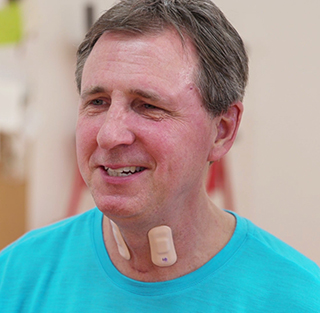 A connected sensor patch developed by Northwestern University engineers and the Shirley Ryan AbilityLab, a research hospital in Chicago, could allow clinicians to better monitor stroke patients as they recover at home.
A connected sensor patch developed by Northwestern University engineers and the Shirley Ryan AbilityLab, a research hospital in Chicago, could allow clinicians to better monitor stroke patients as they recover at home.
The sensor is comprised of stretchable electronic technology that is both comfortable for patients to wear and accurate enough for use during rehabilitation, according to researchers. By adhering the sensor to the skin on a patient’s neck, it can measure the swallowing and speech pattern metrics used by clinicians to diagnose and treat aphasia, a communication disorder associated with stroke.
“Stretchable electronics allow us to see what is going on inside patients’ bodies at a level traditional wearables simply cannot achieve,” John A. Rogers, a professor at Northwestern’s engineering and medicine schools whose lab developed the material, said in a statement. “The key is to make them as integrated as possible with the human body.”
The material — which Rogers demonstrated and discussed this weekend at the American Association for the Advancement of Science’s annual meeting in Austin, Texas — offers an advantage over the microphones often used to measure stroke patients’ speech, since these can’t distinguish between the patient’s voice and other noise. Rogers said that his technology can directly measure the vibrations of a patient’s vocal cords, and do so comfortably.
“[The sensors] only work when worn directly on the throat, which is a very sensitive area of the skin,” he said. “We developed novel materials for this sensor that bend and stretch with the body, minimizing discomfort to patients.”
Rogers’ throat sensors are employed at Shirley Ryan AbilityLab alongside others using similar technology to measure heart function, arm movement, step count, and other metrics key to stroke recovery, according to the university. These additional sensors are placed on the arms, legs, and chest, and transmit their readings wirelessly to avoid the discomfort that often accompanies traditional wired sensors.
“One of the biggest problems we face with stroke patients is that their gains tend to drop off when they leave the hospital,” Arun Jayaraman, research scientist at the Shirley Ryan AbilityLab, said in a statement. “With the home monitoring enabled by these sensors, we can intervene at the right time, which could lead to better, faster recoveries for patients.”
Further enabling home monitoring is a clinician dashboard developed for the sensors. Here, practitioners can view a continuous reading of their patient’s collected data on their computer, smartphone, or tablet, and also may receive specific alerts when a patient’s recovery is falling short.
“Talking with friends and family at home is a completely different dimension from what we do in therapy,” Leora Cherney, a research scientist at the Shirley Ryan AbilityLab who focuses on aphasia treatment, said in a statement. “Having a detailed understanding of patients’ communication habits outside of the clinic helps us develop better strategies with our patients to improve their speaking skills and speed up their recovery process.”
According to Northwestern, Rogers’ lab is also collaborating with the research hospital to measure the sensors’ impact on other diseases such as Parkinson’s.















